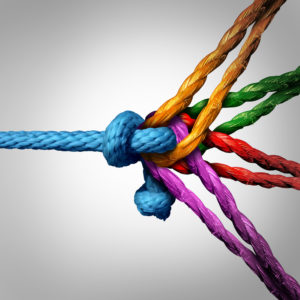Fresh off a pleasant few weeks complete with presenting at a conference, finishing up a client project, and reconnecting with friends and family, Monday was an abrupt return to the lonely world of the executive. A client (let’s call her Angela), a senior leader at her company, confided to me how terribly disconnected she feels at work. The old adage “it’s lonely at the top” could have been written for her. As an example, Angela had just presented her company’s strategic vision to the entire workforce, her likeness broadcast simultaneously to thousands of people in over 200 countries, and yet she said she felt oddly alone.
In my own leadership roles, I’ve experienced isolation as an integral part of the job. Consider: We leaders are often privy to information we legally and ethically cannot share. In the formal role of boss, we conduct evaluations, give feedback, and make tough decisions (such as announcing layoffs) that may affect peers and friends. All of these responsibilities create a sometimes necessary division between us and others. But that’s hardly all there is to it.
I’ve also personally found that a sense of belonging—participating in authentic, life-giving networks and relationships— is absolutely essential to balance out those periods of isolation. Being connected with others doesn’t just feel good; it has a direct impact on my energy level, outlook on life, and leadership performance. In my years living and working amid foreign cultures, until I really had that feeling of “I belong”, my sleep was restless, I was lethargic during the day, and I know I wasn’t functioning at my peak. Those are the same kind of symptoms I heard from Angela. For me, I’d even say belonging is as important as keeping up with new trends in my field, eating well, engaging in a regular mindfulness practice, and exercising (no small admission from a committed data, nutrition, yoga, and workout enthusiast).
Apparently I’m not alone. Back in 2009 the National Heart Institute’s Framingham Study theorized: our connections with others impact our health and happiness. Based on data from 15,000 people spanning three generations, the primary researchers Christakis and Fowler found:
“the happiest people in Framingham were those who had the most connections, even if the relationships weren’t necessarily deep ones. . . . Happiness doesn’t come only from having deep, heart-to-heart talks. It also comes from having daily exposure to many small moments of contagious happiness.”
Maybe that’s part of the key: cultivating belonging means tending to the small shoots as well as the big branches. If this infographic on our global networking habits is any indication, we have a universal need as human beings to connect, even if on seemingly minor and superficial levels. We are undeniably social.
Different forms of connection work for different individuals however; it’s not as simple as huddling up everyone you see. Building a sense of belonging (and it is important that you start building it rather than waiting for it to show up gift-wrapped on your desk or doorstep) can be as simple as reaching out with calls, emails and other social nudges to meaningful contacts, or can be as involved as taking part in a service project to benefit others. For executives like Angela who feel like an outsider but long to belong, here are a few ideas I recommend:
- Take a few minutes to scan Jane Pauley’s inspiring interview with Philip Burguieres, one of the youngest CEOs to ever run a F500 company until depression brought his career screeching to a halt. He attributes much of his eventual recovery to creating a “health regimen that includes social support.”
- Ask someone around you to go on a walk or enjoy a cup of tea together. The act of interacting with people purposefully can be a simple yet highly restorative boost to your sense of connectedness and wellbeing.
- Watch Wellesley Center for Women’s Amy Banks, M.D., explain the neurobiology of interpersonal relationships and wellbeing. She shows how healthy relationships are critical to the functioning of four neural pathways shaping our sense of calm, acceptance, resonance, and energy. (Her latest book Four Ways To Click is exceptional too.)
- Apply the ideas in management author Peter Block’s book, Community: The Structure of Belonging. He writes about overcoming the isolation and anxiety felt in our modern lifestyles and creating a social fabric of energy and hope right where we are at the moment. His book isn’t new, but for restoring generosity and connection in our families, organizations, and communities, it is more relevant now than ever.
- Express your gratitude. (These 15 film shorts by acclaimed filmmaker Louie Schwartzberg are sure to help!) The act of being grateful provides a proven pathway to counteract the disconnection we often feel in our lives, between one another, and with the planet.
You don’t exist as an island; you are hardwired to connect. Consequently, being a leader doesn’t eliminate the need to belong. When you tend to this need personally, you are better equipped to build healthy organizations and better-working societies. You’re also more apt to appreciate the new reality: leadership is as much a collective act as it is an individual one. The complex challenges we face as human beings and organizations are truly better met with the wisdom of a thriving “me” and a thriving “we”.
To empower your personal and collective leadership with tools and practices for thriving, contact me at renee@wisdom-works.com.
READ MORE
- The Magic Of Executive Presence
- Ready To Fully Engage In Life And Leadership? Disengaging First May Be The Key
- The Path Of The Evolving Leader: Leadership As Practice
- Is The Planet Ready For A Different Way Of Leading?
- Ready To Boost Leader Effectiveness And Wisdom? Try Mindfulness!
- Success Means Taking Care Of What Enables You To Thrive
- Leading From Authenticity: Boosting Your Energy, Impact, and Wellbeing
- Wellbeing Leadership: Where Are YOU On This Journey?
Shutterstock Image: 351655727






